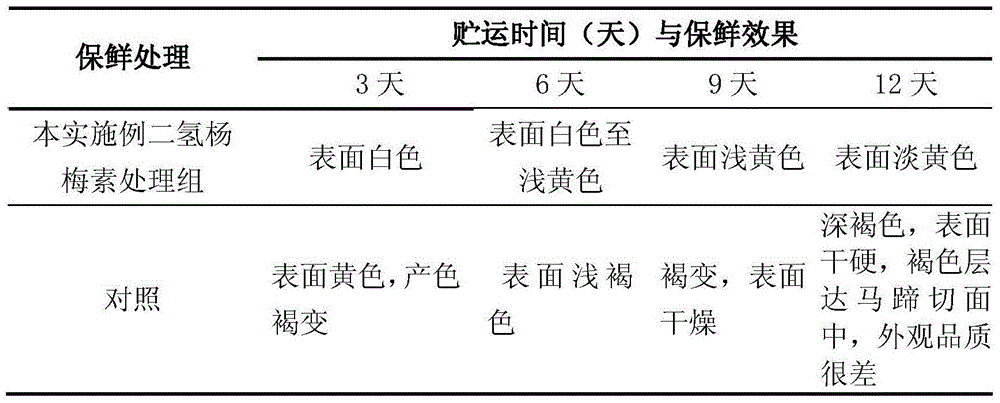Preservation method for freshly-cut root vegetables
The technology of a root vegetable and fresh-keeping method is applied in the fresh-keeping field of fresh-cut root vegetable, which can solve problems such as being unusable, and achieve the effect of delaying aging and reducing respiratory intensity
- Summary
- Abstract
- Description
- Claims
- Application Information
AI Technical Summary
Problems solved by technology
Method used
Image
Examples
Embodiment 1
[0026] Example 1: fresh-cut and fresh-keeping taro
[0027] Taroes were purchased from a specialty street market in Lechang, Shaoguan, Guangdong Province, with a single weight of 2.5-4.5 kg; plastic lunch boxes, cling film and fresh-keeping bags were purchased from supermarkets; disposable paper bowls were packaged by Shaoneng Group Guangdong Oasis paper molded products Limited offer.
[0028] Preparation of dihydromyricetin: add water to the young leaves, or shoots, or the mixture of young leaves and shoots of Snakesia dentata or Snake grapes in a weight ratio of 1:10, heat to boiling, and keep warm for extraction After 60 minutes, filter or centrifuge while it is hot, and collect the extract; add water again at a weight ratio of 1:5, heat to boiling, and extract with heat for 20 minutes, filter or centrifuge while it is hot, and collect the extract; concentrate the extract to 20% of the original volume, add edible alcohol until the ethanol concentration is 60%, heat to boil...
Embodiment 2
[0037] Embodiment 2: Peeled horseshoe and fresh-keeping
[0038] Horseshoes are purchased from a specialty street market in Lechang, Shaoguan, Guangdong Province. Plastic lunch boxes, plastic wrap and fresh-keeping bags are purchased from supermarkets.
[0039] Prepare dihydromyricetin solution: dihydromyricetin is added with water to form an aqueous solution with a mass concentration of 0.1%.
[0040] Raw material pretreatment: select intact Lechang horseshoes, wash them with water, and manually peel them with a knife.
[0041] Fresh-keeping treatment: Soak the peeled horseshoes in the fresh-keeping solution for 2 minutes, pick up and drain, then pack the horseshoes in plastic boxes, 500-1000 grams per box, and seal them with PE plastic wrap or fresh-keeping bags. Store at 1-4°C.
[0042] Control group: take the peeled horseshoe that has not been treated with dihydromyricetin as the control group, and store it at 1-4°C after aliquoting.
[0043] Test method: During storag...
Embodiment 3
[0047] Embodiment 3: Preservation of peeled taro
[0048] The taro taro was purchased from farmers’ markets in Guangzhou; plastic lunch boxes, plastic wrap and fresh-keeping bags were purchased from supermarkets.
[0049] Dihydromyricetin solution: dihydromyricetin is added with water to form an aqueous solution with a mass concentration of 0.05%.
[0050] Select intact yams, wash them with water, and peel them manually with a knife; soak the peeled yams in dihydromyricetin solution for 0.5 minutes and pick them up, and let the water on the surface of the peeled yams dry until there is no obvious water drop , packed in plastic boxes, 500-800 g / box, and sealed with PE plastic wrap or plastic bags; those not treated with dihydromyricetin were used as the control group. Store at 4-8°C.
[0051] The results showed that after 21 days of preservation, the fresh-keeping taro was intact and basically free from browning, while the unfresh-keeping taro had partly browned after 7 days,...
PUM
 Login to View More
Login to View More Abstract
Description
Claims
Application Information
 Login to View More
Login to View More - R&D
- Intellectual Property
- Life Sciences
- Materials
- Tech Scout
- Unparalleled Data Quality
- Higher Quality Content
- 60% Fewer Hallucinations
Browse by: Latest US Patents, China's latest patents, Technical Efficacy Thesaurus, Application Domain, Technology Topic, Popular Technical Reports.
© 2025 PatSnap. All rights reserved.Legal|Privacy policy|Modern Slavery Act Transparency Statement|Sitemap|About US| Contact US: help@patsnap.com


